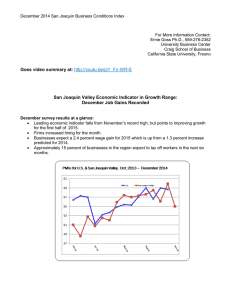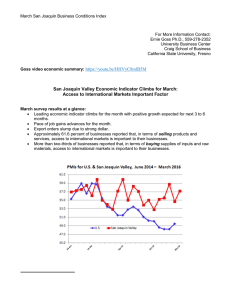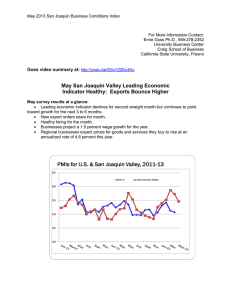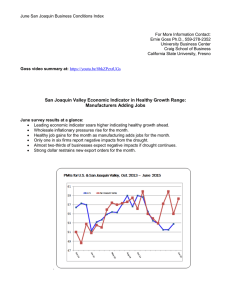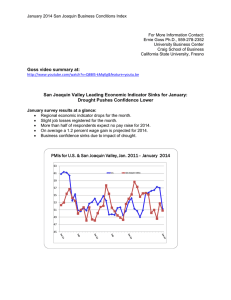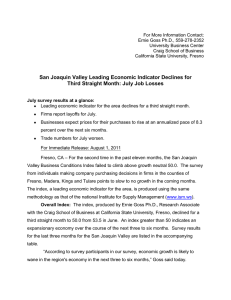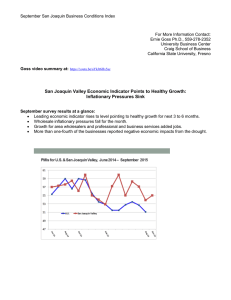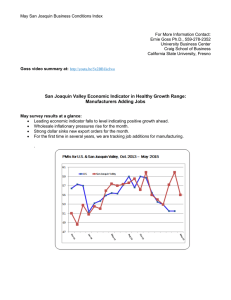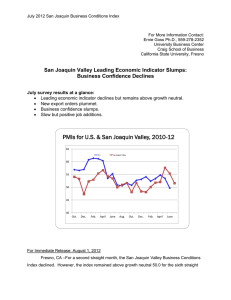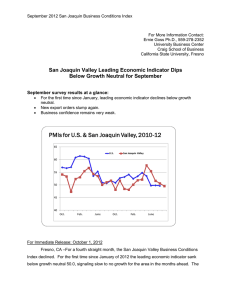For More Information Contact: Ernie Goss Ph.D., 559-278-2352 University Business Center
advertisement
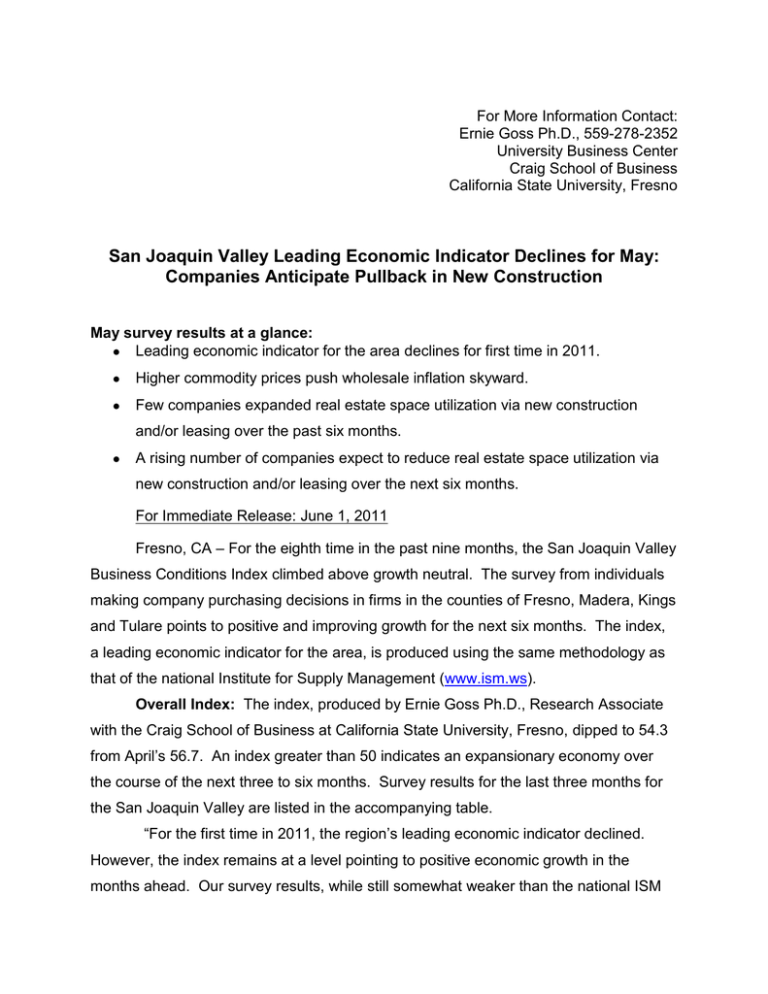
For More Information Contact: Ernie Goss Ph.D., 559-278-2352 University Business Center Craig School of Business California State University, Fresno San Joaquin Valley Leading Economic Indicator Declines for May: Companies Anticipate Pullback in New Construction May survey results at a glance: Leading economic indicator for the area declines for first time in 2011. Higher commodity prices push wholesale inflation skyward. Few companies expanded real estate space utilization via new construction and/or leasing over the past six months. A rising number of companies expect to reduce real estate space utilization via new construction and/or leasing over the next six months. For Immediate Release: June 1, 2011 Fresno, CA – For the eighth time in the past nine months, the San Joaquin Valley Business Conditions Index climbed above growth neutral. The survey from individuals making company purchasing decisions in firms in the counties of Fresno, Madera, Kings and Tulare points to positive and improving growth for the next six months. The index, a leading economic indicator for the area, is produced using the same methodology as that of the national Institute for Supply Management (www.ism.ws). Overall Index: The index, produced by Ernie Goss Ph.D., Research Associate with the Craig School of Business at California State University, Fresno, dipped to 54.3 from April’s 56.7. An index greater than 50 indicates an expansionary economy over the course of the next three to six months. Survey results for the last three months for the San Joaquin Valley are listed in the accompanying table. “For the first time in 2011, the region’s leading economic indicator declined. However, the index remains at a level pointing to positive economic growth in the months ahead. Our survey results, while still somewhat weaker than the national ISM San Joaquin Business Conditions Index – p. 2 of 4 survey outcome, point to improving economic conditions in the next three to six months,” Goss said today. Employment: “The hiring gauge slipped to 55.6 from April’s 56.6. “Manufacturing firms in the area have added net new jobs for each month of 2011. This growth has spilled over into the rest of the economy. Even with recent growth, the area’s employment level is down by more than 25,000 jobs. Our survey indicates that the area will continue to add jobs through the third quarter of this year. However, that growth is likely to be muted by historical standards,” reported Goss. Wholesale prices: The prices-paid index, which tracks the cost of raw materials and supplies, dipped to a still inflationary 84.2 from 85.6 in April. “Higher commodity prices, especially for energy products, continue to reduce the profitability and hiring for manufacturing firms, especially food processors, in the area,” said Goss. “Firms continue to report unacceptably high inflationary pressures at the wholesale level. Even though the Federal Reserve (Fed) indicated it would end its buying of long-term U.S. Treasury bonds, quantitative easing 2 (QE2), this summer, I expect the Fed’s record low short-term interest rates to continue to weaken the dollar and push inflation above the Fed’s comfort zone,” said Goss. This month we asked survey participants how their firms have changed their real estate utilization over the past six months and how their real estate utilization will change for the next six months. Approximately 3.3 percent indicated that they had expanded real estate utilization while less than one percent reported reducing real estate space utilization over the past six months. The remaining 95.7 percent indicated that their real estate utilization had not changed over the past six months. “For the next six month period, approximately 15.6 percent indicated that they expect their firm’s real estate space utilization to expand while 21.0 percent anticipate a reduction in real estate space utilization. The remaining 63.4 percent indicated that their real estate utilization would not change over the next six months,” said Goss. San Joaquin Business Conditions Index – p. 3 of 4 One survey participant reflected the lack of enthusiasm for expansion saying, “I am currently looking for a space about half my current size. Our lease runs out in December so we will begin searching in earnest next quarter.” Business Confidence: Looking ahead six months, economic optimism, captured by the May business confidence index, declined to 57.1 from 62.5 in April. “Higher commodity prices, elevated unemployment rates and a weak construction sector continue to restrain the economic outlook for the San Joaquin Valley economy,” said Goss. Trade: New export orders for May were healthy. The May export orders reading climbed to 63.7 from April’s 57.5. The area’s import index sank to 59.9 from 66.5 in April. “While the Federal Reserve’s cheap money policies are pushing domestic prices upward, they have served to reduce the value of the U.S. dollar thus making U.S. goods more price-competitive abroad. Those same policies have increased the price of imported goods,” said Goss. Inventories: The inventory index, which tracks the change in the inventory of raw materials and supplies, sank to 48.3 from April’s 55.0. “The decline in inventory levels reflects reduced economic optimism among survey participants as they became slightly less confident about future sales growth,” said Goss. Other components: Other components of the May Business Conditions Index were new orders at 56.9, down from April’s 59.1; production or sales at 57.4, down from 60.1; and delivery lead time at 53.3, up from 52.8 in April. The Craig School of Business uses the same methodology as a national survey by the Institute for Supply Management, formerly the Purchasing Management Association, which has formally surveyed its membership since 1931 to gauge business conditions (www.ism.ws). The overall index, referred to as the Business Conditions Index, ranges between 0 and 100. The overall index is a mathematical average of indices for new orders, production or sales, employment, inventories and delivery lead time. Table 1 details survey results for the last three months. June survey results will be released on the first business day of next month, July 1. San Joaquin Business Conditions Index – p. 4 of 4 Table 1: Overall and component indices for last 3 months (above 50.0 indicates expansion) March 2011 55.4 56.3 59.3 54.8 53.8 52.8 84.2 64.6 56.6 63.8 Leading economic indicator New orders Production or sales Employment Inventories Delivery lead time Wholesale prices Imports Export orders Business confidence San Joaquin Valley April 2011 56.7 59.1 60.1 56.6 55.0 52.8 85.6 66.5 57.5 62.5 May 2011 54.3 56.9 57.4 55.6 48.3 53.3 84.2 59.9 63.7 57.1 PMIs for U.S. & San Joaquin Valley, 2010-11 65 U.S. San Joaquin Valley 60 55 50 45 40 Oct. Nov. Dec. Jan. Feb. March April May Craig School of Business: http://www.craig.csufresno.edu/ Follow Goss: Twitter at http://twitter.com/erniegoss or www.ernestgoss.com
